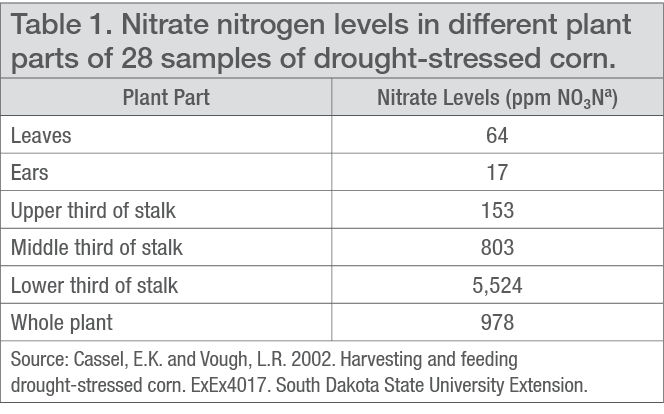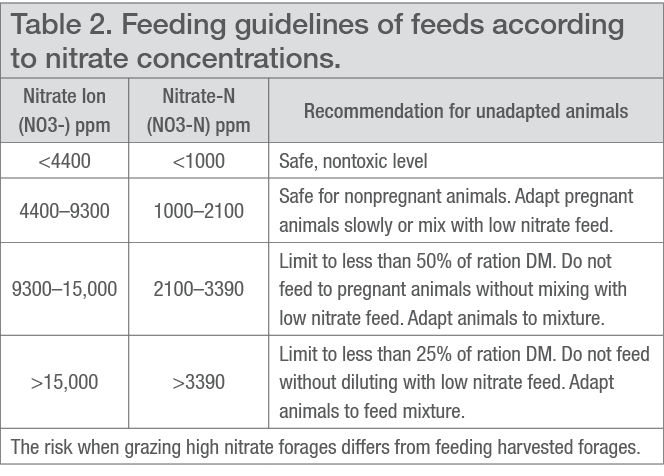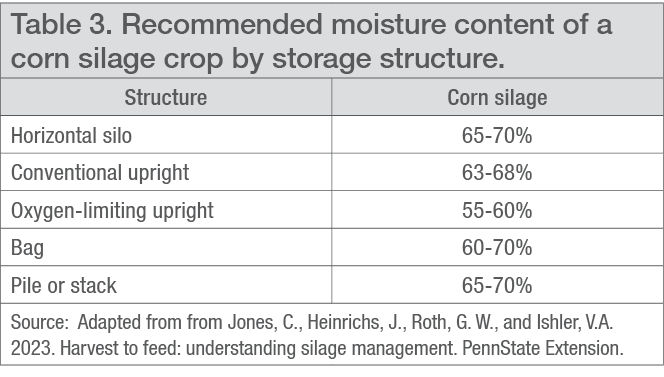Utilizing Drought-Stressed Corn for Silage
March 11, 2024
Introduction
Droughts severely impact corn crops in many corn producing areas, almost every year. If the drought timing, length, and severity is enough to negatively affect ear development, then a producer may be forced to decide to leave the crop and harvest what corn grain is produced, harvest the crop for silage if it is an option, or destroy the crop. A corn crop with compromised yield due to drought stress may still be salvageable as a silage crop. With proper management, drought-stressed corn can make good animal feed. When deciding if silage harvest is an option there are many important factors to consider.
Key Considerations Prior to Silage Decision
- Are there on-farm silage needs or a local silage market available?
- Is silage harvest equipment available for a timely harvest?
- How will the silage be stored after harvest?
- Can harvest timing occur at the correct whole plant moisture content needed for optimal fermentation for the storage structure type?
- Test the corn crop for potentially toxic levels of nitrates that can accumulate in drought-stressed plant tissues.
- Check pesticide pre-harvest intervals recently applied to the field.
- Scout for ear mold that can cause a mycotoxins problem in drought-stressed corn fields.
- Understand the consequences of plant removal on soil fertility and soil moisture retention.
- Check with your crop insurance agent before harvesting a corn crop insured for grain production before it is harvested for forage or silage or you may forfeit insurance indemnities.

Assessing the Crop for Grain or Early Silage Harvest.
If corn has successfully pollinated and there is evidence of kernel growth (blisters are forming on the ear) despite drought conditions, the best alternative may be to wait for grain to develop. If pollination is disrupted enough that plants will be partially or completely barren, the crop may be harvested as a silage crop as soon as whole-plant moisture levels are appropriate for the silage storage structure that will be used.
Precautions for Harvesting Drought-Stressed Corn
Potentially toxic nitrate levels may be detected in a drought-affected corn crop. High levels of nitrates in the plant can be toxic when fed to animals and can produce a gas that is lethal to humans and livestock. Nitrates can accumulate in plants when there is a large amount of nitrate in the soil and normal growth is interrupted, such as during drought stress. Nitrate accumulation is higher if rain or an irrigation is applied as soil water moves the nitrates from the soil into the roots where they are taken up by the plant. It usually takes three to four days before these nitrates are converted by the plant into proteins, so waiting the three to four days is recommended. Obtain an analysis for nitrates in the crop prior to harvest. Nitrates accumulate in the stalks and leaves, with highest concentrations in the lower part of the plant and other conductive tissues (Table 1).1

Cutting drought-stressed corn for silage is preferred over grazing or green chopping because fermentation during the ensiling process can help reduce nitrate concentration by approximately by 1/5 to 2/3.1 Allow silage to ferment at least one to two months prior to feeding. Raising the cutter bar to 12 inches above the soil surface and avoiding harvest immediately following a drought-ending rain or irrigation can further reduce nitrate levels. If high nitrate levels were found at harvest, test the silage again before feeding to animals to ensure it is safe for livestock consumption (Table 2).2

Mold and mycotoxins can also be a problem when a corn crop has been grown under high temperatures and moisture stress. Corn kernels affected by molds by themselves do not cause problems when fed to animals however the mycotoxins produced by mold can cause serious health problems for livestock. A common mycotoxin that is more prevalent when a corn crop is under drought stress is aflatoxin caused by Aspergillus fungi, which when fed to animals, can cause poor feed efficiency, reproductive problems, suppression of the immune system or even death. Ear molds found in the field before harvest can have different appearances. Aflatoxin-causing Aspergillus often has a gray-green or olive-green color, fumonisin-causing Fusarium has a white to pink color, and vomitoxin or zearalenone-causing Giberella often has bright pink color. Ensiling a corn crop that contains mycotoxins usually does not decrease the mycotoxin levels in the feed. There are many mycotoxins are problematic in silage affected by the growing weather conditions including aflatoxins, trichothecenes, ochratoxin A, fumonisins, vomitoxin or zearalenone, and many other fungal secondary metabolites so it is important to test any silage grown under drought stress for mycotoxins to understand the concentrations and management strategies needed to feed these types of mycotoxins affected silages.3

Harvest moisture content
The optimum harvest moisture depends on the storage structure used (Table 3).4 Harvesting drought-stressed corn too soon can result in silage with excess moisture, which can lead to poor fermentation and reduced feed value. When moisture levels are too low, fermentation is reduced resulting poor feed quality and less breakdown of nitrate. It is important to check whole-plant moisture prior to using drought-stressed corn for silage. The stalks may contain over 70% moisture even though the leaves appear dry and are turning brown. If whole-plant moisture is greater than 75 to 80%, harvest should be delayed, or the corn can be windrowed and allowed to field wilt before using a pick-up attachment on the chopper to harvest the crop for silage. Drought-stressed corn should be chopped to 3/8-inch in length for harvesters without a grain processor and ¾-inch for harvesters with a grain processor the roll clearance should be set at 2-3 mm (0.08 to 0.12 inches) to help it pack better for fermentation and storage.

Feed Value and Pricing Drought-Stressed Silage
The value of a drought-stressed corn silage crop can be challenging when considering the variability and length of stress that the corn crop has been under. The silage yield of drought-stressed corn can be estimated by assuming that one ton of 30% dry matter silage can be obtained for each five bushels of grain per acre. If no grain is expected, plant height can be used to estimate yield. For each foot of plant height (excluding the tassel) approximately one ton of 30% dry matter silage would be predicted. For example, if corn is six feet tall, five feet would be harvested, resulting in five tons/acre.5 A producer considering selling drought-stressed corn for silage should have a forage analysis conducted to assess the quality of the feed. The feed value of silage from drought-stressed corn with minimal or no grain is typically between 70 to 80% of that of normal corn silage (Table 4).5 A drought-stressed silage is generally lower in energy but higher in protein content than normal silage (Table 5).6 The producer should also consider tonnage, moisture content and other factors based on current prices.


There are many ways to determine the value of a drought-stressed corn silage crop. The Corn Silage Decision Tool spreadsheet from North Dakota State University can help determine valuation. 7 Another good resource to help put a value on a drought stressed corn crop that is being considered for silage harvest can be found at https://dairy.osu.edu/newsletter/buckeye-dairy-news/volume-14-issue-4/pricing-drought-stressed-corn-corn-silage.
Biomass Removal from a Silage Harvest
The removal of corn for silage can have a negative effect on soil fertility, soil moisture conservation, and increased soil erosion issues by harvesting the crop residue (biomass) that would have been left on a corn field harvested for grain. Because a substantial amount of biomass is removed when corn is harvested as silage, several times more nitrogen (N), phosphorus (P) and particularly potassium (K) is removed than would be if the crop was harvested for grain. Without the crop residue cover, more soil moisture can be lost due to evaporation along with the potential for wind and water erosion issues that can occur when the crop residue is removed from the soil surface with silage harvest. Producers shouldn’t lose sight of the consequences of nutrient removal and plan to replace lost nutrients prior to seeding the next crop, particularly for crops with high K requirements, like alfalfa or soybean. Also understand the soil health issues that can often follow a management practice that reduces the plant biomass left on the soil surface.
Conclusion
- A corn crop that has been compromised by drought stress and is expected to yield little or no grain may be salvageable as a silage crop.
- A concern with drought-stressed corn is the potential for high levels of nitrates in the plant which can be harmful to humans and livestock.
- The most important process for quality silage production is proper silage harvest management which includes correct whole plant moisture at harvest, chop length, silage packing, and silage sealing.
- Loss of soil nutrients, soil moisture, and concerns about soil and water erosion due to whole plant removal are other concerns when considering a silage harvest option.
For additional agronomic information, please contact your local seed dealer or agronomist.
Sources
1 Cassel, E.K. and Vough, L.R. 2006. Harvesting and feeding drought-stressed corn. ExEx4017. South Dakota State University Cooperative Extension Service. https://openprairie.sdstate.edu/extension_extra/116/
2 Drewnoski, M.E., Anderson, B.E., Kononoff, P.J., and Reynolds, M.B. 2019. Nitrates in Livestock Feeding G1779 Nebraska Extension. https://extensionpublications.unl.edu/publication/g1779/html/view
3 Ogunade, I.M., Martinez-Tuppia, C., Queiroz, O.C.M., Jiang, Y., Drouin P., Wu, F., Vyas, D., and Adesogan, A.T. 2018. Mycotoxins in silage: Occurrence, effects, prevention, and mitigation. Journal of Dairy Science. https://www.sciencedirect.com/science/article/pii/S0022030218303254
4 Jones, C., Heinrichs, J., Roth, G. W., and Ishler, V.A. 2023. From harvest to feed: understanding silage management. PennState Extension. https://extension.psu.edu/from-harvest-to-feed-understanding-silage-management#section-28
5 Lauer, J., Undersander, D., Schoessow, K., Faust, J., Milligan, L., and Blonde, G. 2012. University of Wisconsin – Madison. Wisconsin Corn Agronomy - Pricing Drought Stressed Corn Silage. https://www.wisc.edu/search/?q=Estimating+corn+silage+yields
6 Garcia, A. 2021. Using drought-stressed corn as forage. South Dakota State University Extension. https://extension.sdstate.edu/using-drought-stressed-corn-forage#:~:text=Because%20drought%2Dstressed%20corn%20has,in%20the%20field%20is%20recommended
7 Aakre, D., Swenson, A., Carlson, Z., and Haugen, R. 2021. What is the Value of a Standing Corn Crop for Silage? EC1343 North Dakota State University. https://www.ndsu.edu/agriculture/extension/publications/what-value-standing-corn-crop-silage#:~:text=Corn%20Silage%20Decision%20Tool
Web sites verified 2/2/2024. 1227_357957
You may also like...
Here are some articles that may also be of interest to you